| |
The Iron Crosses
History is where you find it, or sometimes, it finds you and you
take advantage of the opportunity. Manteuffel Kaserne and Daley
Barracks had more than its share of notable people pass through and
many of the story lines begin with the first days of the Kaserne and
units of the 2nd Panzer Division. Sometimes it took decades for the
circle to finally close as American cavalry troopers and those they
were destined to meet, finally make contact. Here is the story of
three famous German general officers, each with a link to Bad
Kissingen, and how one squadron commander came to meet two of them.
Johann Adolf Graf von Kielmansegg: From Cavalry Lances to Nuclear
Weapons
The arrival of the 2 Kradschutzen Battalion from Eisenach to Bad
Kissingen and subsequent move into the just finished Manteuffel
Kaserne was captured by the local photographers and some of the
notables are identifiable in the images. There were at least two
formal parades in the Luitpold Park, one with the troops dismounted
and one, with all the equipment. The battalion adjutant, Captain
Johann Adolf Graf von Kielmansegg, can be found in two images from
these parades.
| |
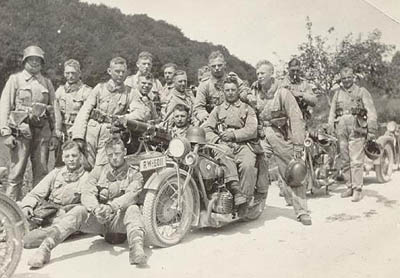 |
|
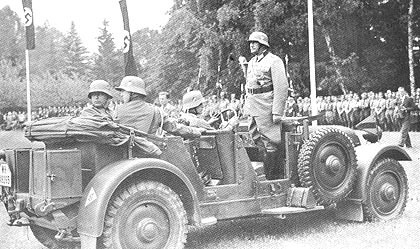 |
|
| |
As Germany begins to
rearm, these motorcycle infantry men stop for a photo during an
exercise. Their officers and tactics found a common theme in the
traditions of German horse cavalry. |
|
Captain or Major
Kielmansegg in open staff car, seated in rear, back to camera, as
the 2 Krad parades in Bad Kissingen shortly after arrival.
--Franz Steinzer |
|
He had entered the Army in 1926 following a
cadet period and had proven himself to be both a capable staff
officer and commander. Assigned to a high visibility position as the
adjutant of the 2 Kradschutzen Battalion, his career continued on a
steady upward path. Once the war began, while not highly decorated
in combat, he continued though a progression of staff and command
positions and survived some of the most furious bombings of Berlin
as well as fierce combat on the Eastern Front. He ended the war as a
colonel in command of a regiment.
In the post war period, his first thought was publishing but he soon
found his way into the circle of influential Germans, known as the"
monks", who would help shape the new constitution, independent
government and NATO integration of West Germany. Brilliant and free
from overt past connection to the Nazi Party or war crimes and from
a noted but not particularly affluent aristocratic family,
Kielmansegg was an ideal choice for high rank as the Bundeswehr was
re - authorized in 1955. By 1966, he was a general officer and
Central Commander of NATO Strategic Weapons. Following his
retirement, he continued as an influential leader working for German
"policy and methods" study groups always seeking to insure that
Germany and the liberal West were linked by common goals. On
occasion, his name could be found as a senior contributor to the
political analysis process on documents written as late as the
1990s.
Without doubt, General Kielmansegg returned to Bad Kissingen in the
post war years. We have yet to uncover the US Army contacts he may
have had during his visits. His speeches to new generations of
military cadets and students of political science would usually
begin,
| |
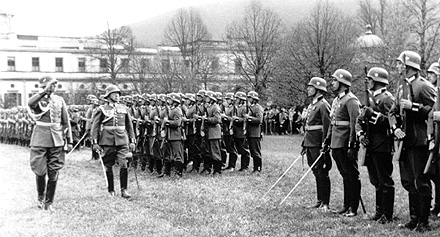 |
|
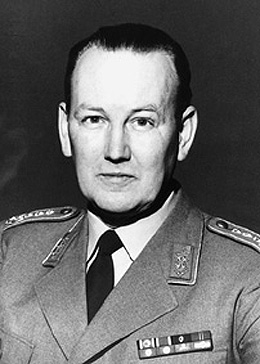 |
|
| |
Kielmansegg seen with
saber, closest to camera, at ceremony in 1938.
--Stadtarchiv Bad Kissingen |
|
General Kielmansegg in
the Bundeswehr in the mid 1960s.
--Gamma |
|
"My career has spanned service in the three
German Armies of the modern age, the Reichswehr, the Wehrmacht and
the Bundeswehr ... my cadet days were spent with the cavalry lance
and at the end, I commanded NATO’s nuclear weapons. Through all of
this, I have tried to see myself as a man of peace and
communication."
Hasso von Manteuffel: the Long Shadow
Hasso von Manteuffel began his military career as a cadet in 1908.
From a famous Prussian family noted for both military and political
service, when the Second World War ended, he held the grade of
Commander in Chief of the 5th Panzer Army. His rise through the
ranks, once given a combat command, reflects one of the most
spectacular records of any German general of that era.
Interestingly, Manteuffel missed the opening campaigns in Poland and
France. An officer of many talents, his significant organizational
and teaching abilities had long been recognized by General Guderian
and he was posted as a senior staff officer at the Panzer Troops
Training School II at Berlin - Krampnitz while his peers were in
combat in 1939 and 1940. Not until the preparations for the invasion
of Russia in 1941, did Lieutenant Colonel Manteuffel take command of
a motorized rifle battalion in the 7th Panzer Division. Once combat
against the USSR began, Manteuffel consistently won decisive battles
and rapid promotions followed.
| |
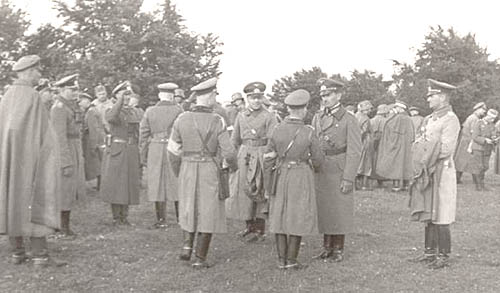 |
|
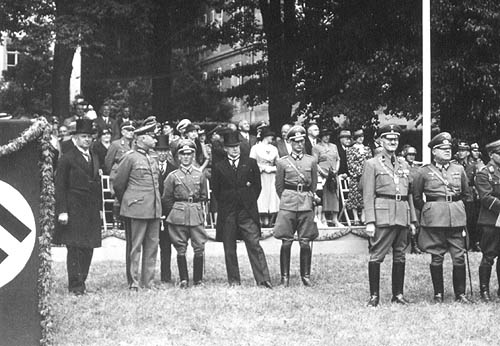 |
|
| |
Pre war images of Hasso
von Manteuffel are very rare. He is seen here, sometime in the mid
1930s, right - center of frame, back to camera, in a rather formal
pose as staff officers and commanders meet during a pause in an FTX.
The personnel wearing arm bands or engineer tape on their sleeves or
hats, to include Manteuffel, are umpires. True to their cavalry
heritage, many of the men pictured wear spurs. |
|
As the 2 Krad parades
at the Luitpold park on 1 June 1937 during the opening ceremony for
their new barracks, an unknown photographer takes a few images of
the assembled dignitaries. Major Hasso von Manteuffel is caught in
the scene, standing with an unidentified general, second officer
from the right. --Norbert Ruckel |
|
His war record includes, battalion and brigade
command in Russia and upon promotion to general, service with the
Africa Corps against the British, a second tour on the Russian front
and combat against the Americans during the Battle of the Bulge. A
cavalry officer and then panzer commander, he shared with Guderian
the ability to teach tactics in the classroom and boldly execute
them in the field. Hasso von Manteuffel was also the shortest German
general officer of the war, reports vary but five feet - three
inches is a fair height estimate.
There is an interesting back story related to Hasso von Manteuffel
and his visit to Bad Kissingen in 1968 as recalled by Col ( Ret )
Byers. During a brief stop at Daley Barracks, Manteuffel lectured
the officers of the 2/14 ACR on the Battle of the Bulge, a
presentation in English he gave many times in retirement. He
mentioned he had not previously visited the barracks that bore his
family name and in the interest of brevity, he apparently did not
elaborate. Given time and inclination, however, Hasso von Manteuffel
could have recalled days early in his career and his link to the
city beyond the name cut into the stone pillar at the entrance to
the old Kaserne. He shared a common past with the first German unit
to occupy the barracks, Kradschutzen Battalion #2.
In the mid 1930s, while still stationed in Eisenach, during the
first years following conversion of the 2 Krad to a motorcycle
infantry unit, Captain Hasso von Manteuffel had been both a company
commander and, following promotion to major, the senior staff
officer with the unit. Manteuffel’s early career had been as a horse
cavalry officer, he was an expert rider and had previously commanded
horse cavalry “ squadrons “ - company size units, in the old
Reichsheer.
| |
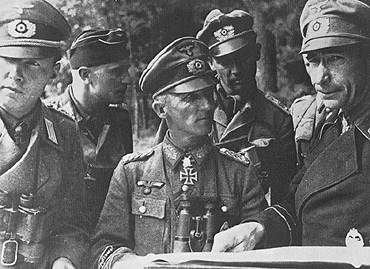 |
|
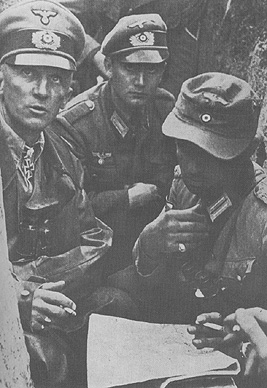 |
|
| |
Manteuffel with staff
somewhere in Russia.
--von Schaulen |
|
... and fighting in
France later in the war.
--von Schaulen |
|
As select cavalry units were motorized during
the modernization of the Heer after Hitler came to power, top
officers were assigned to the “ fast troop “ units to command, learn
and study first hand, the new equipment and tactics. This brought
Manteuffel to Eisenach and the 2 Krad.
As the new barracks was being built in Bad Kissingen and Colonel von
Apell, commander of the 2 Krad, visited the construction site, Hasso
von Manteuffel was at work with the unit staff and missed movement
with the battalion to Bad Kissingen by less than a year. 2 Panzer
Division commander Guderian had recognized Manteuffel as an
exceptional officer and moved him from the 2 Krad to the division
staff in 1937. His new position was to oversee training and school
assignments of all officer cadets and junior officers within the
division. Guderian saw this as a very important task, handed the job
to a key subordinate and in all probability, Manteuffel moved from
Eisenach to the division HQ in Wurzburg.
Some months later, as Guderian left the division for higher command
and supervision of the entire Panzer personnel training system, he
brought Manteuffel to Berlin and the Panzer Troops School. Despite
these rapid moves, Manteuffel did not forget his connection to the
2nd Panzer Division and the last company he commanded.
On 1 June 1937, as the 2nd Kradschutzen Battalion held the formal
parade and opening ceremony for their new barracks, Major Hasso von
Mauteuffel traveled from Berlin to watch the proceedings. He stood
not on the formal reviewing stand but off to the side, in the crowd
of visiting officers and dignitaries. He was captured on film by a
local photographer and the image surfaced in a collection purchased
by Norbert Ruckel. Manteuffel would have recognized most of the men
of the unit as they paraded, there may have been cadets and junior
officers present that held his personal interest and perhaps, he
felt that had duty and Guderian not called him to Berlin, he would
have stood in the lead field car as the battalion commander or
senior staff officer of the motorcycle infantry unit as it occupied
the barracks on the hill that honored his family name.
| |
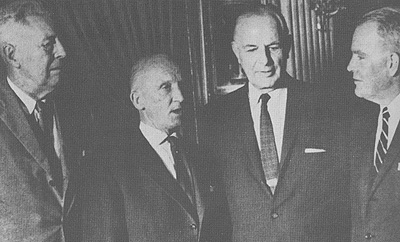 |
|
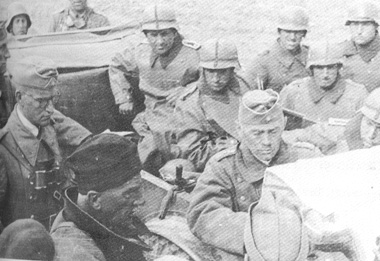 |
|
| |
From left, General
Clark, General Manteuffel, General Hasbrouck and General McAuliffe
recall their roles during the Battle of the Bludge in 1966.
Manteuffel was active in German politics, veteran's affairs and was
an active lecturer recalling his career in the final years.
--von Schaulen |
|
General Vaerst, seated
near right with soft cap, checks his map as the regiment moves
forward.
--Franz Steinzer |
|
In the post war years, following parole,
Manteuffel was very active in first local then national German
politics and as early as 1950, was loudly calling for an accelerated
return of sovereignty to West Germany, partnership with the western
allies and rearming of his nation to resist Soviet expansion. His
call for at least thirty German divisions raised American and
British eyebrows. Of the significant German generals who survived
the war and were not tainted by war crimes, Manteuffel maintained
the highest profile yet in 1956 as the new German Army was
authorized, he was not invited to officially participate.
In his later years, writing his memoirs, veteran’s affairs, the
lecture circuit and even assisting Hollywood in movie productions
occupied his time. Hasso von Mantueffel died in the lakes region of
southern Bavarian in the village of Diessen am Ammersee in 1978.
Col (Ret) John Byers:
"The Kaserne in Bad Kissingen was named Manteuffel Kaserne, after
the grandfather of the WWII German general. The elder Manteuffel was
a general under Bismarck and achieved some fame in the
Franco-Prussian War. The Americans put up a sign for Daley Barracks,
but all the Germans kept calling the post Manteuffel Kaserne.
The Oberburgermeister of BK (Dr. Hans Weiss ) invited me to attend a
dinner at the reunion of the 2nd Panzer Division being held in the
city, and I accepted. The main speaker at the banquet was Hasso von
Manteuffel who had commanded that division in combat. He gave a very
stirring speech and, though he was slight in appearance and stature,
he was very obviously a dynamic and forceful leader. After the
dinner, I spoke with him and asked if he would like to visit the
Kaserne (he had never been there) and address my officers the next
day. He agreed, and I hurried back home to get things organized,
including alerting COL Gordon Allen, CO 2d ACR, of the impending
visit."
CSM (Ret) Jefferies:
"Yes, I recall that very well. LTC Byers asked me to look into the
protocol for a visit of this nature and frankly, I had no idea! I
certainly knew how to render the correct military honors to a
visiting foreign dignitary or an allied senior officer but this
seemed way past what I was familiar. I also remember that my older
brother had been shot at by those guys is WWII. I guess I figured
something out that was small and dignified."
Col (Ret) Byers:
"The next morning (Sunday, as I recall), all my officers assembled
in the squadron mess, COL Allen flew in from Nurnberg, General von
Manteuffel arrived promptly on schedule, we fell out the guard and
the general solemnly inspected them, and then we went to the mess.
He spoke in flawless English and reviewed the Battle of the Bulge
and the mistakes the Germans made. Then he took questions (and there
were lots of them), COL Allen thanked him in German (he sort of
preempted me as host), and the general departed after shaking hands
with several of the young officers. It was a very impressive event
and quite impromptu, and my guys talked about it for weeks.”
Gustav von Vaerst: the Old Lion
Gustav von Vaerst, junior to Manteuffel by a few years but at least
in the pre war years, far advanced in terms of command assignments,
came from another noted German family; the traditional family
estates were located near Meiningen. A solid background in both
cavalry and infantry, he saw himself as a "soldier’s - soldier" and
enjoyed the competition with his men is all manner of skills. In
1924 he was proud to win a ceremonial saber for carbine shooting
skills.
By 1938, he had already commanded a motorized rifle battalion in the
2nd Panzer Division and was being groomed for promotion to colonel
and eventual command of the 2nd Schutzen Regiment in Meiningen. A
part of this command was the 2nd Krad located in Bad Kissingen.
Vaerst successfully led this regiment through fighting in Poland,
France and Greece and his departing efficiency report notes
"Splendid man of high personal standards. Practical, clear, calm and
determined in his leadership and issuance of commands in the face of
the enemy! He has proven outstanding and is a Knight’s Cross
holder." Vaerst certainly would have known Hasso von Manteuffel,
whether or not they were friends is unknown.
Upon leaving the 2nd Panzer Division, Vaerst briefly assumed duty as
a staff officer at the School for Mobile Troops before taking
command of the 15th Panzer Division in North Africa. Here, he
soldiered as both a successful division commander and acting army
commander until the final defeat of the force in mid 1943 and his
capture by the British. He spent the balance of the war as a POW and
following parole in the early 1950s, returned to what remained of
his family’s land holdings to live quietly on a hunting lodge in the
town of Nordheim, near Fladungen.
| |
 |
|
| |
General Vaerst with the
Africa Corps shortly before his capture in 1943. His post war
activities are currently not known.
--Gamma |
|
Gustav von Vaerest died at the lodge in the
early 1970s.
Col ( Ret ) Byers:
“The other general you mentioned was Major General von Vaerst. I
don't remember his first name. I heard about this old panzer
division general from my BK friends and one day I looked him up. He
lived near Mellrichstadt in a hunting lodge that belonged to his
family. The von Vaerst line was one of the oldest in Germany. His
crest was a gold shield with a thick red horizontal line across it
(a bend jules on a shield d'or); nothing more, nothing fancy. Most
of his land was in East Germany, with only the hunting lodge and
some acreage on our side of the border. He lived simply, with only
his wife and a couple of servants for help. He spoke sadly of his
ancient line because he had no sons to carry on the von Vaerst name.
His daughter kept her name, mostly to please him, he thought, but
her children bore their father's name. He had been captured in North
Africa and spent much of the war in POW camps in America. After the
war, he lectured at CGSC and AWC and was quite familiar with the
American Army.
CSM Jeffries and I visited him several times, and I would take some
good Franken wine to him."
CSM (Ret) Jeffries:
"I recall those visits with LTC Byers to see the old German general.
I remember the wine was very good ."
Col (Ret) Byers:
"When I left the 2/14, I invited him to the change of command
ceremony and an unusual thing happened. We had a lot of Germans
there, both Bundesgrenschutz and Bundeswehr officers, Zoll Polizei,
BK officials, and many friends. They were all milling around,
talking, finding seats, etc when this little old man walked in. I
was talking to LTC Harms, my successor, when there was a sudden
hush; everybody stopped talking and all the Germans, even the
ladies, stood up in respect to the little old general. Then, one by
one, the German officers came up to him, saluted and spoke quietly
to him. Dr Weiss, the BK Oberburgermeister, did the same and later
told me he was very surprised to see the general and more surprised
that I knew him. My stock with the Germans went up a hundred-fold
that day.” |
|